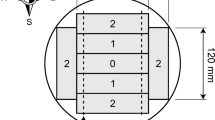Abstract
The objective of this study was to evaluate the effect of lamina distortion control on the production yield of cross-laminated timber (CLT) using domestic larch (Larix kaempferi) wood. The measured production yield of CLT was 27 %. The yields based on log volume of sawing, planing, cross-cutting, and finish planing of CLT were 49, 66, 96, and 86 %, respectively. The yield of sawing and planing can be improved by controlling distortion during drying. Using an experimental enforced-loading apparatus, the cup and twist of laminas were reduced by 50 and 90 %, respectively. To analyze the effect of a reduction in sawing dimensions on the final production yield of CLT, an analysis of a geometrically applied sawing pattern of logs was used to predict the sawing yield and the number of laminas after sawing. The geometrical analysis showed that a change in the sawing dimensions affected the production yield of CLT. If the width and thickness of the sawing dimensions can be reduced by 5 mm by decreasing the distortion of lamina during drying, the sawing yield was unchanged (49 %), but it was expected that the number of laminas after sawing would increase from 278 to 303. It was also predicted that the production yield of CLT would increase from 27 to 32 %.



Similar content being viewed by others

References
Fujimoto T, Akutsu K, Kazuhito K, Uchiyama K, Kuromaru M, Oda K (2006) Age trends of genetic parameters of spiral grain in hybrid larch F1 and implications for efficiency of early selection. J Wood Sci 52(2):101–106
Gagnon S, Popovski M (2011) Structural design of cross-laminated timber elements. In: Chapter 3, CLT handbook. FPInnovations, Quebec, p 67
Gustavsson L, Sathre R (2006) Variability in energy and carbon dioxide balance of wood and concrete building materials. Build Environ 41(7):940–951
Hallock H, Lewis DW (1971) Increasing softwood dimension yield from small logs—best opening face. USDA Forest Service. Research paper FPL-166, Madison, p 11
Han Y, Chang YS, Park JH, Jeong GY, Hong JP, Lee JJ, Yeo H (2013) Analysis of residual drying stress in Larix kaempferi wood used as glulam laminar. J Korean Wood Sci Tech 41(6):535–543
Ikami Y, Murata K, Matsumura Y, Tsuchikawa S (2009) Influence of pith location on warp of lumber in sawing medium-quality sugi (Cryptomeria japonica D. Don) logs. Eur J Wood Prod 27(3):271–276
Jeong GY, Lee JJ, Yeo H, Hong JP, Kim HK, So WT, Chung WY (2013) Optimized lamina size maximizing yield for cross laminated timber using domestic trees. J Korean Wood Sci Tech 41(2):141–148
Johansson M, Perstorper M, Kliger R, Johansson G (2001) Distortion of Norway spruce timber. Part 2. Modelling twist. Holz Roh-Werkst 59(3):155–162
Korean standards association (2004) Measurement of sizes and determination of volume for sawlogs. KS F 2163
Kubojima Y, Kobayashi I, Yoshida T, Matsumoto H, Suzuki Y, Tonosaki M (2013) Twisting force during drying of wood. Eur J Wood Prod 71(6):689–695
Ormarsson S, Dahlblom O, Petersson H (1998) Numerical study of shape stability of sawn timber subjected to moisture variations. Part 1: theory. Wood Sci Technol 32(5):325–334
Pnevmaticos SM, Moland P (1978) Hardwood sawing simulation techniques. Forest Prod J 28(4):51–55
Schickhofer G (1994) Starrer und nachgiebiger Verbund bei geschichteten, flächenhaften Holzstrukturen (rigidly and flexibly jointed laminated timber plates) (In German) Dissertation. Technische Universität Graz, Austria
Taylor FW, Mitchell PH (1990) Effect of conditioning and mechanical deflection on the warp of kiln-dried southern pine studs. Forest Prod J 40:42–44
Yoshida T, Itoh Y, Hashizume T (2005) Fabrication of a vertically laminated beam composed of two Japanese larch beams and its bending strength. Wood Industry 60(2):65–69
Acknowledgments
This study was conducted with the support of the Forest Science & Technology Projects (Project No. S111214L100120) provided by the Korea Forest Service.
Author information
Authors and Affiliations
Corresponding author
Rights and permissions
About this article
Cite this article
Han, Y., Park, JH., Chang, YS. et al. The effect of controlling the drying distortion of laminas on the production yield of cross-laminated timber (CLT) using Larix kaempferi wood. Eur. J. Wood Prod. 74, 519–526 (2016). https://doi.org/10.1007/s00107-016-1008-3
Received:
Published:
Issue Date:
DOI: https://doi.org/10.1007/s00107-016-1008-3



